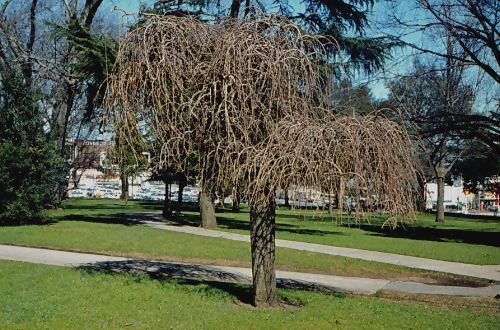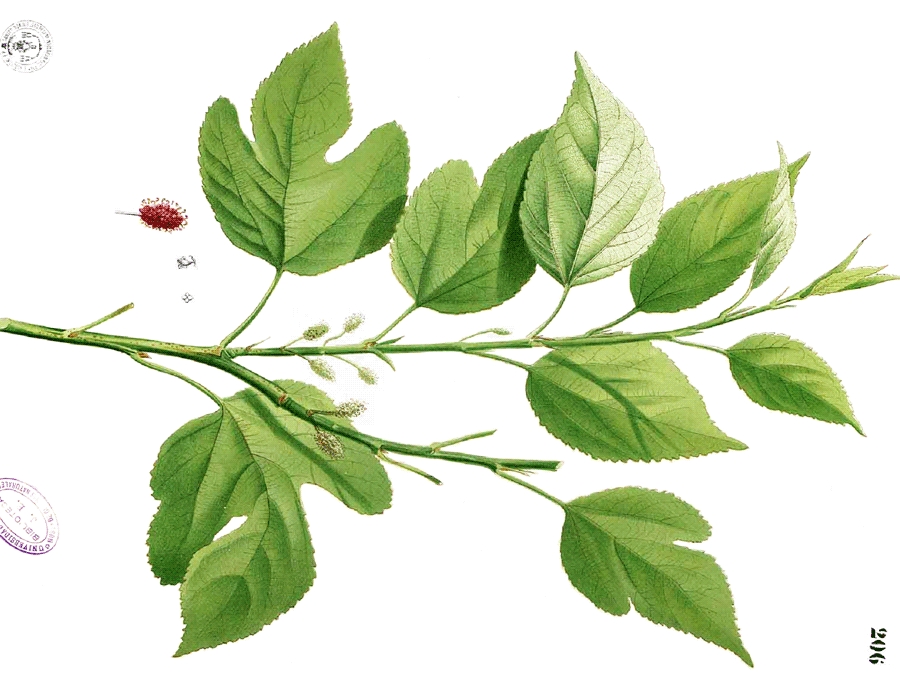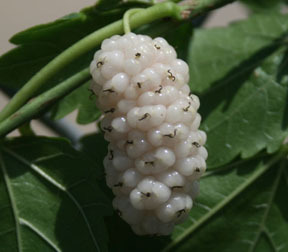White Mulberry : Natural History
To be able to truly appreciate the White Mulberry and benefit from it, one must first be able to identify it. The scientific classification is Morus alba, and it is within the Morus, or Mulberry family. In Spanish, alba is one way to define its white color. This tree has transcended many places and shares many names, including the French language, in which it is referred to as the “Murier blanc.” Paying ode to its original habitat, it is called Ti-song in Chinese (Rafinesque, 1839).
The White Mulberry could be mistaken for a shrub at times, as it can range in size from very petite to 20-50 feet (USDA Forest Service, 2013). The tree can be cultivated in a variety of ways, but its most common form is that of the Pendula, which is named for its overhanging shape. It resembles a bulbous mushroom, with its weepy branches loosely hanging down (Brand, 2001).
During the winter and early spring months, this tree is fairly plain - looking decrepit with its long and spindly branches (shown in Figure 2). As it is a deciduous plant, it loses its leaves during the cold seasons. During the spring and summer, the leaves can take on a variety of shapes. Its leaves are alternate, meaning they do not oppose each other on a stem or branch (Moore). Just like the diversity seen in snowflakes, the leaves of a White Mulberry are often eclectic and diff from one another. Even before an insect has reached a leaf, it may appear as if some critter has nibbled the edges. The leaves often have defined lobes or may be notched along the edges (Gilman, 2012). They have a glossy surface that makes them shine in the summertime. In autumn, they turn a delightful yellow (USDA Forest Service, 2013).
In addition to its pleasant appearance, the White Mulberry is relatively hardy. This easily invasive species has been found all across the United States (Gilman, 2012). It is very adaptable, and capable of growing in numerous soil types; however, it prefers moist soil and a position best for capturing sunlight (Moore). The White Mulberry can tolerate both flooding and extremely dry conditions. It has fewer predators than some trees, but it is still susceptible to bacterial infections, many types of fungi, and insects (USDA Forest Service, 2013).
It naturally occurs dioeciously, which means that every plant has either male or female parts. However, the plant is known to be able to switch from monoecious and dioecious forms (Rhodus, 2002). The White Mulberry is able to propagate itself with the help of its male and female flowers. The male plant will have flowers that appear in green on long catkins, whereas the female plant has subtle flowers that appear as small white spikes congregating together (Boyce). It is also distributed when animals ingest its fruit. Then there is the process of human cultivation, which depending on the environment, may involve many intricate steps to acquire and dry the seeds from a berry and plant them. There are a variety of ways to cultivate the White Mulberry.
To identify a White Mulberry, it is helpful to know what it looks like relative to the Red Mulberry (Morus rubra). One easy way to differentiate is the White Mulberry’s glossy leaves, which are not found on the Red Mulberry. The Red Mulberry produces very red fruit, hence its name. These red fruits are known to have a slightly less flat taste and more of a desired tartness to them (CRFG, 1997). The Red Mulberry’s fruit is strongly colored with a deep red dye that can stain children’s faces and clothes.
As a young tree, the White Mulberry has orange-tinted or tannish bark that eventually gives way to a brownish color (Rhodus, 2002). The outer bark is typically coarse. A lesser known fact, is that the inner bark can be used as a thickener in soups or as a bread making ingredient (Moore). The White Mulberry is known to have a smoother bark with a lighter color than the Red (Cobb, 1833). And lastly, if you find the tree in the summer months, you can note its horrid looking fruit, as seen in the figure below. It is ripest towards the month of August. They occur in cylindrical shapes with a bunch of drupes attached to a green stem (USDA Forest Service, 2013). The ripe berries can appear in a variety of colors, even on one tree, from white, red, purple and black. But not surprisingly, the white berries are most commonly associated with the White Mulberry (Stone, 2009).



